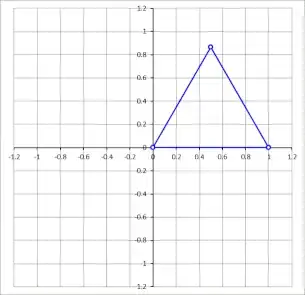Let $v_x(t)$ denote the position of the vertex on the $x$-axis at time $t$, $v_y(t)$ denote the position of the vertex on the $y$-axis at time $t$, and $v(t)$ denote the position of the third vertex at time $t$.
First, note that
$$ v_x(t)^2 + v_y(t)^2 = 1, $$
as this is the length of the side of triangle between these two points. An entirely reasonable parameterization of these two vertices is, then
$$ v_x(t) = (\cos(t), 0)
\qquad\text{and}\qquad
v_y(t) = (0, \sin(t)). $$
The third vertex can be found by starting at the midpoint of this segment, and traveling $\frac{\sqrt{3}}{2}$ units in a direction perpendicular to the segment. Abusing notation a little,
$$ v(t)
= \underbrace{\frac{1}{2} (\sin(t), \cos(t))}_{P} + \underbrace{\frac{\sqrt{3}}{2} \langle \cos(t), \sin(t) \rangle}_{\mathbf{v}}
= \left( \frac{1}{2} \sin(t) + \frac{\sqrt{3}}{2}\cos(t), \frac{1}{2} \cos(t) + \frac{\sqrt{3}}{2} \sin(t) \right). $$
Here, the notation $P + \mathbf{v}$ denotes the addition of a point and vector—start at the point, and travel along the vector to arrive at a new point. That being said, the addition actually works "componentwise" so, hopefully, nothing too difficult is happening here.
The vector $\mathbf{v}$ does, perhaps, require a little bit of explanation. The vector from $v_x(t)$ to $v_y(t)$ is
$$ \mathbf{u}(t) = v_y(t) - v_x(t) = \langle -\sin(t), \cos(t) \rangle. $$
A vector perpendicular to this is obtained by swapping the entries, and changing the sign of one of the two entries (the choice of which entry's sign is changed comes down to orientation—in the original image, the third vertex sits above the $x$-axis when $t=0$, hence the choice of $\mathbf{v}(t) = \langle \cos(t), \sin(t)\rangle$).
I sketched all of the above up in GeoGebra, and obtained the following image (note that the naming of the vertices is different, as GeoGebra has its own conventions):

The complete GeoGebra demonstration can be found at https://www.geogebra.org/calculator/jtehwfh7 .
The moral of the story is that the curve can be parameterized by the function
$$ v(t) = \left( \frac{1}{2} \sin(t) + \frac{\sqrt{3}}{2}\cos(t), \frac{1}{2} \cos(t) + \frac{\sqrt{3}}{2} \sin(t) \right), $$
where $t$ runs over the real numbers (though $v$ is $2\pi$-periodic, so it is only necessary to parameterize over, say, $[0,2\pi]$).
I claim that this is a parameterization of an ellipse. However, instead of reinventing the wheel, I will refer the interested reader to https://math.stackexchange.com/a/2647450/ , where a generalized parameterization of an ellipse is derived. One can work backward from the linked answer to the formula in the question.

